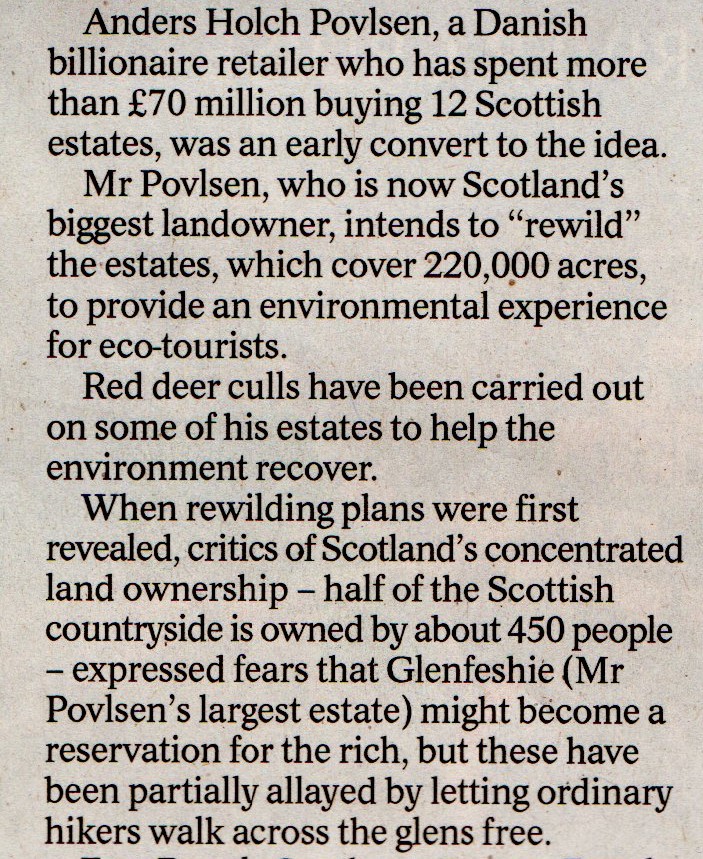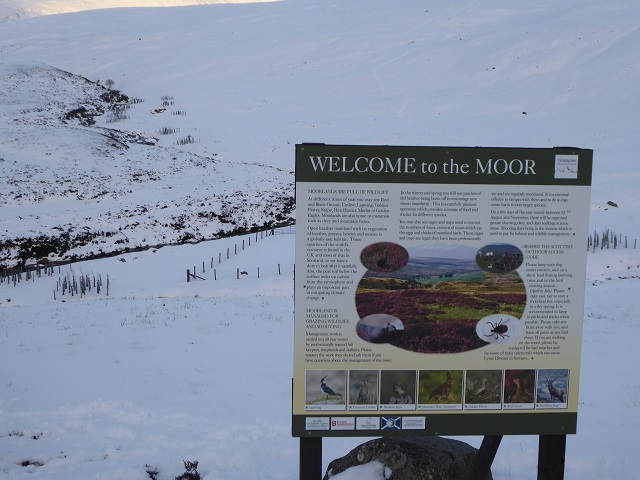
This extract appeared in a generally informative article about growing interest from the private sector about buying Scottish Estates for their environmental potential. That raises lots of interesting questions, not least whether Agencies like Savill’s who were quoted in the piece, are now are being motivated by the potential to make a quick buck out of carbon offsetting. However, anything that helps put an end to the environmental destruction being caused by sporting estates would be welcome. The damage done by large numbers of Red Deer and Muirburn has gone on far to long.
Unfortunately, when it came to Anders Povslen and Glen Feshie, the article was misleading:
- To say Mr Povlsen intends to “re-wild” the estates he has bought, suggests this is something for the future. In fact, that process has now been going on for over 14 years, since he bought Glen Feshie in 2006. What has happened there has transformed our understanding of the ecological potential of the land in the Cairngorms and provides a yardstick with which to compare the success of conservation management elsewhere (National Trust of Scotland at Mar Lodge, RSPB at Abernethy etc).
- To say that “culls have been carried out on some of his estates” misrepresents the central importance that Wild Land Ltd has placed on reducing the numbers of Red Deer on its land. It is this that has resulted in Glen Feshie becoming the best example of re-wilding in Scotland. Deer numbers there have been reduced to around two per square kilometre and that is why tree re-generation has been so much faster than at Mar Lodge, for example, where the latest targets are five deer per square kilometre.
These, however, are mere quibbles compared to the claim that fears that Glen Feshie might become a preserve for the rich “have been partially allayed by letting ordinary hikers across the glens for free”.
First, this ignores the legal right to roam in Scotland – no landowner can prevent hikers from crossing the glens and they certainly can’t charge people for this.
Second, its does an absolute disservice to Povlsen and the staff who manage Wild Land Ltd’s Estates. Unlike most other private estates in the Cairngorms National Park there are no hypocritical “Welcome to the Moor Signs” that, when you read the small print, unlawfully recommend walkers to keep to the path where possible:

It cannot be said enough that we have a general right of access in Scotland, not a restricted right to walk along paths. Any person or organisation that asks people to keep to the path is effectively undermining that general right. That is why its so wrong that the Cairngorms National Park Authority’s logo is on the “Welcome to the Moor Signs” and also why they should be insisting all these signs should be removed.
Glen Feshie appears to one of the few private estates which really recognises and respects the fact that there is a general right of access in Scotland and that means you can walk where you want, path or not. That explains why there are no Welcome to the Moor signs on the estate, indeed there are almost no access signs at all, apart from those put up by Scotways marking historical routes and signs helping people find the Ruigh Aiteachain bothy. Given the proliferation of access signs elsewhere, all of which seek to limit access in some way, that is extremely refreshing and welcome.
It would be foolish not to have reservations about any large landowner, whatever they were doing. To claim, however, that fears that the Glen Feshie estate might become a reserve for the rich have been “partially allayed by letting ordinary hikers across the glens for free” is unfortunately peddling myths. I recall hearing that said before and suspect the article has simply repeated something written somewhere else. We need to stop those myths circulating if we want an informed debate on land use and if we want land, whether in our National Parks or not, to be better managed.
Perhaps it’s time for the Cairngorms National Park Authority media team to consider setting up a fact checking service for journalists?

Absolutely right. Feshie is both a beautiful example of regeneration and one of the friendliest places to walk. Complete public ownership might be the best option, but railing that sympathetic, intelligent, owners such as Poblsen and his team are a decent option.
Indeed. Not only is there now (of course) no restriction of access in Glenfeshie under Anders POvlsen ownership, but a great deal of effort has gone into improving the paths there. That’s quite a contrast to the situation in the 1990s, when the estate was managed as a traditional sporting estate and a notice stating “DEER CULLING KEEP TO THE RIVER FESHIE” greeted walkers thinking of heading to high ground.
No, not bitter here, Nick.
Those of use without literary agents and/or contacts in the MSM will continue to do our best for minimal reward and maximum effort, while the rest get it twisted and/or remix and reconstitute our material from the comfort of London, Manchester and Central Belt. That is, unless CNPA want to take you up on your suggestion, in which case they know where I am.
The lazy churnalism for the Herald probably came from this article.
https://www.theguardian.com/environment/2020/feb/25/the-end-of-farming-rewilding-intensive-agriculture-food-safety
Where Resume is set up as some kind of Paradise.
As for rewilding well we will see, but once again it looks like (to me) an Urban populace imposing their desires on a rural situation. When we see snipe and wetland meadows with tertiary ecology then we will have rewilding.
Thanks very much – a direct quote on access! I had not seen the Guardian article but vaguely recall seeing similar words before so maybe the Guardian lifted the phrase from somewhere else? Churnalism indeed!
I thought the ‘allowing ordinary hikers across the glens for free’ was reference to work undertaken on the bothy, thereby affording free accommodation for ‘ordinary hikers’ meaning folks not renting accommodation from the estate. Thereby enabling access.
I cycled up the Allt Chomhraig between Tromie and Feshie today-with another completely new track driven into this extensively peaty glen. If this and the other new tracks were for a wind farm what would be the reaction? I agree with this track construction project but the biodiversity of Feshie and Gaick might, at this time of year, be compared unfavourably with Pitmain. Three days ago on sheep grazings by the ruins of the infamous Black Officer`s property at Ballachroan-on Pitmain-I counted upwards of 150 peewits and down on the flats of the same estate 17 curlew. Although,I thoroughly dislike that estates fenced plantations of non natives and their avian aliens and their unsightly tracks and…,and..It also has to be recognised that Feshie is not alone in the area for seeing regeneration of woodland-though nothing like on Feshie`s scale. Local keepers and foresters have suggested that Feshie is offsetting carbon taxes by their planting,that the motivation of Wildlands is not at all altruistic . I support the forest`s extension. I just missed seeing a caper the other day.Sometimes I wonder,though, if concern for the human ecology of the area is lacking
Very glad to see your comment : “That is why its so wrong that the Cairngorms National Park Authority’s logo is on the “Welcome to the Moor Signs” and also why they should be insisting all these signs should be removed.” Has this issue been taken to CNPA Board? The signs are all over southern end of the Park too – I couldn’t believe when I saw they are CNPA endorsed. I can’t remember the wording but there is also an implication that management for grouse is good or necessary – the best option (environmentally and economically) – all of which is highly inaccurate.
With respect (and speaking as a visitor to your part of the world – I live close to the top of England, not the top of Scotland), your position on this:
“hypocritical “Welcome to the Moor Signs” that, when you read the small print, unlawfully recommend walkers to keep to the path where possible:”
is deeply problematic.
Simply put, there is NOTHING unlawful about RECOMMENDING that walkers conduct themselves in a certain way WHEN POSSIBLE: that’s just asking them not to be tools – which I’m sure we all agree is the preferred way to do things.
2003 Act says that such signage is illegal.